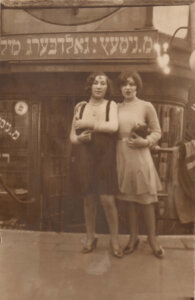My grandmother Gertrude (left) with her friend, Rose Courtesy of Jennifer A. Stern
As soon as we published Jennifer A. Stern’s article, “A photo of my bubbe when Jewish stores still had Yiddish signs,” it drew many readers and much commentary on social media, particularly on Facebook. Many praised the author’s thoughtful analysis of the photo.
We also received email messages from two readers, adding their own observations of the photo. The first is by David Mazower, the research bibliographer and chief curator at the Yiddish Book Center:

Thank you to Jennifer and to the Forverts for sharing this wonderful family photo. I enjoyed Jennifer’s insights and her observations on “how two Yiddish-speaking immigrant girls spent their day out.” I love how they have adopted the exact same pose for the camera, their feet in perfect symmetry, like two dancers. They’re clearly channeling the fashionable attitude of a thousand shop windows mannequins and magazine photographs. And yet, they (and their photographer) haven’t quite perfected the modelling gaze; especially Gertrude’s friend who seems to be caught in the act of composing her expression. They’re endearingly aspirational, but they’re also, and equally endearingly, amateurs.
As Jennifer points out, the shop sign also makes the photograph special. It’s almost certainly hand-painted, from an era when painting and lettering shop signs was a hard-won craft skill. And it’s beautifully worked, as precise and balanced as the lettering that traditionally framed hand-drawn ketubot. By the 1950s and ‘60s, Yiddish shop and shtibl signs on the Lower East Side and in other immigrant neighborhoods tended to be much cruder than the elegant letter forms in this magical photograph.
The second letter is by Chana Bursztyn, a retired physician in Evanston, Illinois:
I’m wondering if the round sticker medallion on the storefront’s left window could be a sign indicating that there is a public telephone inside. Bell Telephone did have such signs in the 1930s.
To the right in the photo is a metal railing that looks to have what appear to be outer garments like coats or capes hanging on it. I’m wondering if they belonged to Gertrude and Rose, who may have placed them on the railing while being photographed in their alluring finery. After all, what 20-year-old woman wants to cover up her attractive legs?
1911, the year Gertrude was born, was also the year of the devastating Triangle Shirtwaist Factory fire, only about two miles from where Gertrude and Rose were photographed. It’s easy to imagine that two of the doomed young women in that 1911 fire may very well have frequented similar local businesses and taken similar photographs. It’s also easy to imagine young women today visiting that neighborhood, perhaps to visit the nearby Tenement Museum, and having a souvenir photo taken. If so, I hope a devoted granddaughter in the future unearths such a photo one day and writes about it, as you have done.

